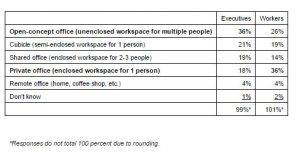August 22, 2016
Managers and staff in creative sector disagree on what makes a creative office 0
 According to a survey by recruitment firm The Creative Group, managers and employees in US based ad agencies don’t see eye to eye on the essential characteristics of a creative office. When asked what the ideal work environment is for on-the-job innovation, the top response among advertising and marketing executives was an open plan workplace. Employees, however, seem to prefer more private, concentrated time, with a private office being the most popular option. According to the study of 1,400 US based ad agency managers, executives and employees, over a third of managers favour open plan environments compared to just a quarter of employees. Twice as many employees as managers would also rather have a private office. Around a fifth of both groups opt for a cubicle. Perhaps the most interesting finding of the report is that just 4 percent of both groups think the best option is remote working.
According to a survey by recruitment firm The Creative Group, managers and employees in US based ad agencies don’t see eye to eye on the essential characteristics of a creative office. When asked what the ideal work environment is for on-the-job innovation, the top response among advertising and marketing executives was an open plan workplace. Employees, however, seem to prefer more private, concentrated time, with a private office being the most popular option. According to the study of 1,400 US based ad agency managers, executives and employees, over a third of managers favour open plan environments compared to just a quarter of employees. Twice as many employees as managers would also rather have a private office. Around a fifth of both groups opt for a cubicle. Perhaps the most interesting finding of the report is that just 4 percent of both groups think the best option is remote working.
 Advertising and marketing executives and workers were asked, “Which of the following workspace arrangements do you think is most conducive to encouraging creativity?”
Advertising and marketing executives and workers were asked, “Which of the following workspace arrangements do you think is most conducive to encouraging creativity?”

“Different tasks call for different work environments,” said Diane Domeyer, executive director of The Creative Group. “Office design should be closely tailored to an organisation’s needs and a team’s primary duties. The main goal for employers should be to create a space where staff members feel comfortable and engaged, and can perform at their best.”
The Creative Group offers four ideas for creating a more stimulating work environment:
Construct creativity zones. Designate a few areas in the office for brainstorming and impromptu meetings. Stock each space with industry publications and an easel pad to jot down ideas.
Offer private sanctuaries. While open floor plans can increase collaboration among employees, some projects require greater focus and concentration. Provide stations where individuals can work in solitude without distraction.
Build a mood board. Encourage team members to post content they find intriguing to a common wall where others can draw inspiration. Also invite staff to take photos of anything they might want to reference for future projects.
Think outside the office. Hold team meetings in a nearby park, courtyard or café. A change of scenery is sometimes all it takes to spark the imagination.














